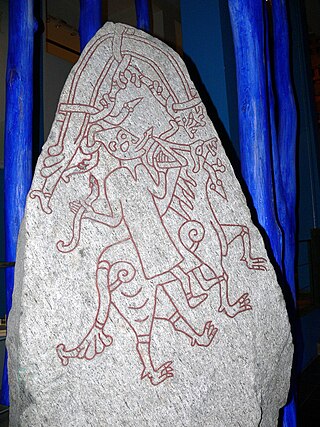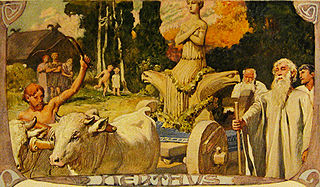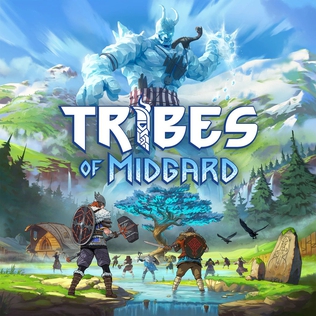In Nordic mythology, Asgard is a location associated with the gods. It appears in several Old Norse sagas and mythological texts, including the Eddas, however it has also been suggested to be referred to indirectly in some of these sources. It is described as the fortified home of the Æsir gods and is often associated with gold imagery and contains many other locations known in Nordic mythology such as Valhöll, Iðavöllr and Hlidskjálf.

In Norse mythology, Freyja is a goddess associated with love, beauty, fertility, sex, war, gold, and seiðr. Freyja is the owner of the necklace Brísingamen, rides a chariot pulled by two cats, is accompanied by the boar Hildisvíni, and possesses a cloak of falcon feathers. By her husband Óðr, she is the mother of two daughters, Hnoss and Gersemi. Along with her twin brother Freyr, her father Njörðr, and her mother, she is a member of the Vanir. Stemming from Old Norse Freyja, modern forms of the name include Freya, Freyia, and Freja.

The terms Jötunheimr or Jötunheimar refer to either a land or multiple lands respectively in Nordic mythology inhabited by the jötnar.

In Norse mythology, Ragnarök is a foretold series of impending events, including a great battle in which numerous great Norse mythological figures will perish ; it will entail a catastrophic series of natural disasters, including the burning of the world, and culminate in the submersion of the world underwater. After these events, the world will rise again, cleansed and fertile, the surviving and returning gods will meet, and the world will be repopulated by two human survivors, Líf and Lífþrasir. Ragnarök is an important event in Norse mythology and has been the subject of scholarly discourse and theory in the history of Germanic studies.

Æsir or ēse are gods in Germanic paganism. In Old Nordic religion and mythology, the precise meaning of the term "Æsir" is debated, with it being able to refer to both the gods in general or specifically to one of the main families of gods, in contrast to the Vanir, with whom they waged war, ultimately leading to a joining of the families. The term can further be used to describe local gods that were believed to live in specific features in the landscape such as fells. In the Old English Wið færstice, the Ēse are referred to, along with elves, as harmful beings that could cause a stabbing pain, although exactly how they were conceived of by the author of the text is unclear.

In Norse mythology, the Vanir are a group of gods associated with fertility, wisdom, and the ability to see the future. The Vanir are one of two groups of gods and are the namesake of the location Vanaheimr. After the Æsir–Vanir War, the Vanir became a subgroup of the Æsir. Subsequently, members of the Vanir are sometimes also referred to as members of the Æsir.
In Norse cosmology, Vanaheimr is a location associated with the Vanir, a group of gods themselves associated with fertility, wisdom, and the ability to see the future.

Mímir or Mim is a figure in Norse mythology, renowned for his knowledge and wisdom, who is beheaded during the Æsir–Vanir War. Afterward, the god Odin carries around Mímir's head and it recites secret knowledge and counsel to him.

In Norse mythology, Ymir, also called Aurgelmir, Brimir, or Bláinn, is the ancestor of all jötnar. Ymir is attested in the Poetic Edda, compiled in the 13th century from earlier traditional material, in the Prose Edda, written by Snorri Sturluson in the 13th century, and in the poetry of skalds. Taken together, several stanzas from four poems collected in the Poetic Edda refer to Ymir as a primeval being who was born from Eitr, yeasty venom that dripped from the icy rivers called the Élivágar, and lived in the grassless void of Ginnungagap. Ymir gave birth to a male and female from his armpits, and his legs together begat a six-headed being. The grandsons of Búri, the gods Odin, Vili and Vé, fashioned the Earth from his flesh, from his blood the ocean, from his bones the mountains, from his hair the trees, from his brains the clouds, from his skull the heavens, and from his eyebrows the middle realm in which mankind lives, Midgard. In addition, one stanza relates that the dwarfs were given life by the gods from Ymir's flesh and blood.

A jötunn is a type of being in Germanic mythology. In Norse mythology, they are often contrasted with gods and other non-human figures, such as dwarfs and elves, although the groupings are not always mutually exclusive. The entities included in jötunn are referred to by several other terms, including risi, þurs and troll if male and gýgr or tröllkona if female. The jötnar typically dwell across boundaries from the gods and humans in lands such as Jötunheimr.
Angrboða is a jötunn in Norse mythology. She is the mate of Loki and the mother of monsters. She is only mentioned once in the Poetic Edda as the mother of Fenrir by Loki. The Prose Edda (Gylfaginning) describes her as "a giantess in Jötunheimar" and as the mother of three monsters: the wolf Fenrir, the Midgard serpent Jörmungandr, and the ruler of the dead Hel.

In Norse mythology, Surtr, also sometimes written Surt in English, is a jötunn. He is the guardian of Muspelheim which is along with Niflheim, the only two realms to exist before the beginning of time, and the greatest of the fire giants. Surtr is attested in the Poetic Edda, compiled in the 13th century from earlier traditional sources, and the Prose Edda, written in the 13th century by Snorri Sturluson. In both sources, Surtr is foretold as being a major figure during the events of Ragnarök; carrying his bright sword, he will go to battle against the Æsir, he will battle the major god Freyr, and afterward the flames that he brings forth will engulf the Earth.

Germanic mythology consists of the body of myths native to the Germanic peoples, including Norse mythology, Anglo-Saxon mythology, and Continental Germanic mythology. It was a key element of Germanic paganism.

Valhalla is a Danish comic series, which offers a comedic view of the gods of Norse mythology. Originally commissioned for and published by Interpresse, it has been published by Carlsen Comics since 1978. In 1986, Valhalla was adapted into an animated feature film the studio A Film. On October 10, 2019, a more serious and dark live action adaptation was released.
The Norse mythology, preserved ancient Icelandic texts such as the Poetic Edda, the Prose Edda, and other lays and sagas, was little known outside Scandinavia until the 19th century. With the widespread publication of Norse myths and legends at this time, references to the Norse gods and heroes spread into European literary culture, especially in Scandinavia, Germany, and Britain. In the later 20th century, references to Norse mythology became common in science fiction and fantasy literature, role-playing games, and eventually other cultural products such as Japanese animation. Storytelling was an important aspect of Norse mythology and centuries later, with the rediscovery of the myth, Norse mythology once again relies on the impacts of storytelling to spread its agenda.

Norse, Nordic, or Scandinavian mythology, is the body of myths belonging to the North Germanic peoples, stemming from Old Norse religion and continuing after the Christianization of Scandinavia, and into the Nordic folklore of the modern period. The northernmost extension of Germanic mythology and stemming from Proto-Germanic folklore, Norse mythology consists of tales of various deities, beings, and heroes derived from numerous sources from both before and after the pagan period, including medieval manuscripts, archaeological representations, and folk tradition. The source texts mention numerous gods such as the thunder-god Thor, the raven-flanked god Odin, the goddess Freyja, and numerous other deities.

Magicka is an action-adventure game developed by Arrowhead Game Studios. It was released via Steam for Microsoft Windows on January 25, 2011.

Magicka 2 is an action-adventure video game, the sequel to Magicka, for Microsoft Windows, Mac OS X, Linux and PlayStation 4. It was released on May 26, 2015 and was announced at Sony's E3 2014 media briefing with a trailer. Instead of being developed by Arrowhead Game Studios, the title was developed by Pieces Interactive alongside the publisher Paradox Interactive.

Norse Mythology is a 2017 book by Neil Gaiman, which retells several stories from Norse mythology. In the introduction, Gaiman describes where his fondness for the source material comes from. The book received positive reviews from critics.

Tribes of Midgard is an action role-playing survival video game developed by Norsfell Games and published by Gearbox Publishing. The game was released for Microsoft Windows, PlayStation 4 and PlayStation 5 on July 27, 2021, and was released for Nintendo Switch, Xbox One and Xbox Series X/S on August 16, 2022.














